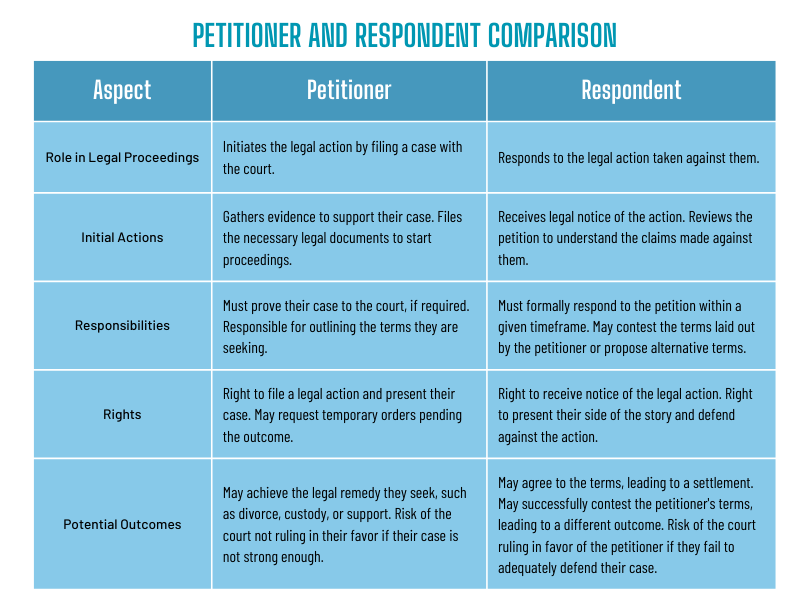
Understanding specific legal terms is not just a matter of semantics—it can significantly impact the outcome of a case. Two such terms that often arise in family law proceedings are “petitioner” and “respondent.” While they might seem straightforward, their roles and implications in legal proceedings can be nuanced.
Definitions
Petitioner:
The petitioner is the individual who initiates or files a legal action. In the context of family law, a petitioner might be the spouse who files for divorce or the parent who seeks child custody or support. The petitioner sets the legal process in motion by presenting their case or claims to the court.
Respondent:
The respondent, on the other hand, is the party against whom the legal action is taken. In family law scenarios, the respondent is typically the other spouse in a divorce case or the other parent in a child custody dispute. The respondent’s role is to respond to the claims or allegations made by the petitioner, either agreeing, contesting, or providing their perspective on the matter.
To further clarify this, we’ve created a table in the image below that outlines the different roles and potential outcomes for each party.

Petitioner vs Respondent in Family Law
In family law proceedings, the distinction between the petitioner and the respondent is clear. The petitioner is the individual who initiates the legal process. This could be someone filing for divorce, seeking child custody, or requesting spousal support. The action commences with the petitioner’s claims or requests.
On the other hand, the respondent’s role is to address these claims. They have the option to agree with the terms, contest them, or propose alternative solutions. Their response can significantly shape the direction and outcome of the case. Often, the petitioner carries the initial burden of proof, meaning they are tasked with providing evidence to support their claims. The respondent then counters this evidence or presents their own.
Both parties have rights, but these rights might vary based on the nature of the case. For instance, in a child custody case, both the petitioner and respondent have the right to seek custody, but the specifics of their claims can differ.
Practical Implications in Colorado Family Law
Family law covers a broad spectrum of scenarios, each with its unique implications for the roles of petitioner and respondent. For instance, in divorce and separation cases, the spouse who files for divorce becomes the petitioner. They present their reasons for the divorce and any initial terms they wish to propose. The other spouse, now the respondent, can then choose to agree to these terms, challenge them, or suggest alternatives.
In child custody disputes, the parent initiating the request is the petitioner. They might be seeking primary custody, joint custody, or specific visitation rights. The respondent, typically the other parent, then has the chance to agree or present their own wishes regarding the child’s care and upbringing.
The dynamics are slightly different in cases of restraining orders within the family law context. If an individual feels threatened or harassed by a family member, they can become the petitioner by filing for a restraining order. The respondent must then either adhere to the order’s terms or contest its validity in court.
Tips for Navigating Colorado Family Law Cases
Navigating the intricacies of family law in Colorado can be challenging, especially when emotions run high and the stakes are extremely personal. Being informed is one of the best ways to ensure that you’re making the right decisions for your situation. Here are some recommendations for those embroiled in family law disputes:
1. Stay Informed: Colorado has specific guidelines and statutes related to family law. Familiarize yourself with these, especially as they pertain to your case. Websites of local legal associations or the Colorado Judicial Branch can be valuable resources.
2. Seek Mediation: Before heading to court, consider mediation. Colorado courts often encourage mediation as a way to resolve disputes amicably. It can be a less adversarial and more collaborative approach to finding solutions.
3. Document Everything: Whether you’re the petitioner or the respondent, documentation can be crucial. Keep records of all interactions, agreements, and relevant events. This can be invaluable when presenting your case or responding to claims.
4. Consult with an Attorney: Even if you’re well-informed, the nuances of family law can be complex. An attorney can provide guidance tailored to your specific situation, ensuring that your rights are protected and that you’re taking the best possible steps.
Conclusion
Understanding the roles of the petitioner and respondent in Colorado family law is more than just grasping legal jargon. It’s about knowing your rights, responsibilities, and the best course of action in what can often be emotionally charged situations.
Being informed and prepared can make a significant difference in the outcome of your case. As always, when in doubt, seeking expert advice can provide clarity and direction in the often complex world of family law.





